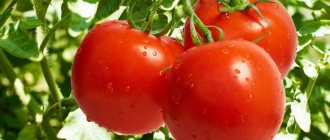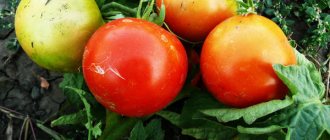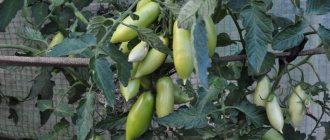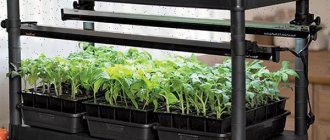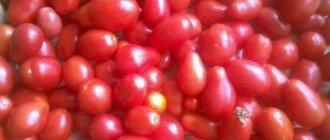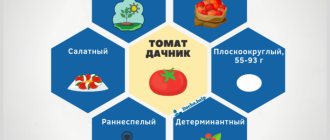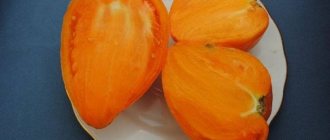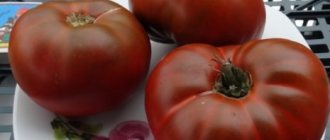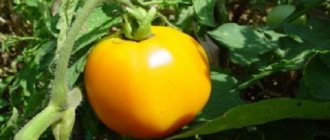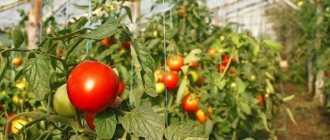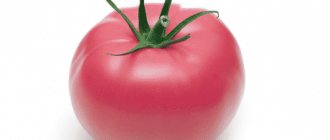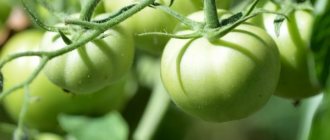Many summer residents consider this variety of tomatoes ideal for growing both in open ground and in apartments. It is pest resistant and does not require special attention. The variety is called: Summer resident.
In addition to the listed advantages, it does not take up much space in the garden when grown and bears fruit for a long time. In addition, many people also love it for the possibility of cultivation on an industrial scale. The plant is easy to care for and has good yield preservation.
Description, characteristics and yield indicators
Fruits collected from one bush have the same, 100% marketable appearance.
Characteristics and description of the tomato variety:
- Variety – determinant.
- Disease resistance is average.
- The bush is small in size, grows up to 50 cm. The stems take up little space, which is convenient for small areas, greenhouses or loggias. There is little green mass on the branches, which allows more sunlight to enter and speeds up the process of fruit ripening.
- The crop is grown both indoors and outdoors.
- The inflorescences of the Summer Resident have a complex appearance. During fruiting, 4-5 fruits are formed on each cluster.
- The variety does not ripen for long. The growing season, depending on the region, is 95-110 days. The crop does well in open ground even in cool weather. The variety manages to bear fruit before late blight begins to appear.
- The best predecessors of the Summer Resident are onions, carrots, cabbage and legumes. It is not advisable to grow vegetables after peppers and potatoes, since the risk of late blight increases significantly.
- The weight of tomatoes ranges from 50 to 150 g. The fruits have a round shape and a bright scarlet color.
- The tomatoes taste pleasant with a slight sourness.
- For early ripening varieties, the yield is decent. From 1 sq. m turns out to be about 4 kg, on an industrial scale - up to 360 c/ha. The bushes are always covered with tomatoes. The plant produces all its fruits before the beginning of autumn.
On a note. 100 g of product contains: 3.3% total sugar, 5.6% dry matter in juice, 17.2 mg of ascorbic acid.
Description of the characteristics of Dachnik tomatoes says that the variety is cold-resistant and universal for growing. For many, these parameters are a priority, so it’s worth taking a closer look at the variety.
Origin and description of the variety
The Summer Resident tomato was obtained by breeding scientists from the All-Russian Research Institute of Vegetable Growing under the leadership of N.S. Gorshkova. The Dachnik variety was registered in the State Register of Russia a long time ago, in 1999. The originator was agro, although the seeds of this tomato variety are offered by many manufacturers.
Comment! Gardeners often confuse the Dachnik tomato variety with the hybrid of the same name, which produces.
In addition, sometimes on sale there are also seeds of tomato varieties with names that also include the word “summer resident” - Ural summer resident, Summer resident of Kuban and others. Of course, all this cannot but introduce confusion into the difficult task of determining the tomato varieties suitable for growing.
Although the Dachnik variety is officially zoned for cultivation only in the North Caucasus region, it is successfully grown in open ground by gardeners in the Central regions, as well as the Urals and Siberia.
The Summer Resident tomato is determinate, so it does not require obligatory pinching, and can reach a height of 60-80 cm. Whether or not to tie these tomatoes is up to you. But due to the weight of the fruit, the stems may not be able to stand it and break or even fall completely to the ground.
Both the seedlings of these tomatoes and the bushes themselves look very strong and stocky, while maintaining compactness.
Attention! Partly due to the compactness of tomato bushes, partly due to the small size of the tomatoes themselves and the general unpretentiousness of the growing conditions, the Dachnik variety is often used for growing indoors and on balconies.
Although the variety of these tomatoes was created exclusively for growing in open ground, it is unlikely that any ordinary gardener would come up with the idea of taking up space in a greenhouse for a tomato, which ripens perfectly in an ordinary garden bed even under not very favorable weather conditions.
The Summer Resident tomato is characterized by a simple inflorescence; up to 10 tomatoes are tied in a brush.
The summer resident tomato belongs to the group of early-ripening tomatoes. Some summer residents even speak of it as an ultra-early tomato, since the first ripe fruits can sometimes be collected on the 85-90th day from the appearance of mass shoots. But usually tomatoes of this variety ripen 95 days after the start of the growing season.
The Dachnik variety is distinguished by quite good yield, especially considering the fact that for early tomatoes this characteristic is not particularly significant. On average, one bush produces about 3 kg of fruit, and with careful care you can get up to 4 kg of tomatoes. Accordingly, in terms of industrial cultivation, the yield of Dachnik tomatoes can range from 300 to 360 c/ha.
Comment! The yield of marketable tomatoes from the total number of fruits can range from 75 to 100%.
A positive aspect in growing tomatoes of this variety is their resistance to low temperatures and to some diseases, such as fusarium and blossom end rot. Tomatoes of the Dachnik variety can be susceptible to late blight, but most often, due to their early ripening, they manage to yield the entire harvest before the time when an outbreak of this disease usually occurs.
Disadvantages and advantages
Tomatoes of the Dachnik variety have more advantages than disadvantages. Gardeners like it for the following reasons:
- the bushes have a convenient compact shape;
- productivity does not decrease even in poorly lit places;
- productivity does not depend on weather conditions;
- tomato grows even on the windowsill;
- fruits ripen early;
- the culture is resistant to diseases;
- bushes do not need gartering or shaping;
- The variety bears fruit for a long time.
Disadvantages: the fruits are small in size and have a sour taste. No other visible defects were observed in the variety.
Tomato Favorite of the Moscow Region - description and characteristics of the variety
Features and characteristics of the variety
In agricultural breeders, they were lucky enough to develop a small-sized tomato variety for growing outdoors. Some plant crops under small film tunnels and temporary shelters.
Distinctive features of the Favorite of the Moscow Region:
- The plant does not need first-class conditions to grow well.
- It takes about 3 months to get the fruit, which is a short period of time for tomatoes to ripen.
- The bushes are the same size, rather compact (about 30 cm).
- On one hand with 8 fruits.
- The leaves have a faint green tint and are small in size.
- The bush does not grow green mass.
- Due to the small size of the plant, the bushes do not need to be tied up.
The main positive feature is unpretentiousness. The culture is capable of providing summer residents with good fruits both in hot and cold weather. Due to the fact that the fruits ripen early, the plant is not susceptible to late blight.
The culture has excellent performance. It is rare to get sick with TMV. Most gardeners have repeatedly noted that pest control needs to be carried out in a timely manner. A cone out of the blue or a whitefly can harm the plant. At night, the plant may suffer damage from slugs.
Harvest
For good germination of the variety, what can you do with excellent lighting. In its absence, there will be no ovaries and the saltyk of tomatoes will not be sweet, but sour. Usually the weather in the Moscow region is incredibly changeable.
The first tomatoes have a very unusual bitterness. The berries of the nightshade plant have a lot of sugar.
How to grow
The summer resident is easy to grow and care for. In the southern regions, seeds are sown directly into the ground in May. In mid-latitudes, tomatoes are sown in unheated greenhouses in May, but when frost-free weather sets in in June, the bushes are transplanted into open ground.
For 1 sq. m of open ground, up to 6 tomato bushes are planted. The great advantage of the variety is that it does not require gartering, formation and removal of stepsons. Immediately after planting, water the plant generously and mulch with a 5-10 cm layer of straw. This will reduce further watering, which is especially convenient if there is a lack of water or if you are not at the dacha often.
If the bushes fall to the ground under the weight of the fruits, they can all ripen calmly on a straw bed. At the same time, they will not be susceptible to various diseases.
Features of care
Caring for the plant is carried out as follows:
- The seedlings are watered in moderation, without flooding, so that mold does not grow on the ground. Otherwise, the black leg will destroy the plant. After the appearance of the second leaf, a pick is carried out. At the same time, pinch the main root at the end, then the bush will be strong and strong.
- The soil near the stem must be loosened, as watering causes it to become crusty. Tomatoes are watered with settled warm water under the plant, in the morning or evening, but not at noon, when it is hot. When it is very stuffy, seedlings need to be sprayed at the same time.
- Fertilizing is carried out as soon as the first ovaries are formed, using diluted manure with clean water in a ratio of 0.5 liters of manure per 10 liters of water. Also mix 1 tsp. superphosphate and 1 tsp. potassium sulfate. Fertilizing is carried out three weeks after planting tomatoes.
- Tomatoes will gain color faster if the fruits are removed after brown spots appear on them. Vegetables will ripen quickly indoors. Heavy branches of bushes are tied to avoid kinks.
- In mid-August, the plants need to be pinched at the top of the stem and all inflorescences removed. This will speed up the ripening time of fruits that have already set.
- If tomatoes lack nitrogen (the leaves turn purple and small), plant 4-5 stem pea bushes around the plant. In 1-2 weeks the bushes will come to life.
For your information. If tomatoes are planted correctly and properly cared for, the summer resident will begin to bear fruit before pests and diseases from other crops spread throughout the garden.
Harvest and storage
The summer resident is distinguished by good preservation of fruits, but there is always the opportunity to extend the shelf life of tomatoes, and it would be foolish not to take advantage of it. Harvested tomatoes last longer if kept at the appropriate temperature.
Important! The duration of preservation of the quality and taste of vegetables depends on proper preparation of the storage and compliance with all necessary conditions.
Experienced gardeners share the following tips:
- store the tomato harvest in a clean, dried and disinfected room (cellar, basement or refrigerator);
- the most suitable temperature for storage is +10…+12°С;
- optimal humidity – 80-85%;
- Light is not needed for long-term storage of tomatoes;
- Tomatoes are preserved better and longer if they are picked unripe.
During storage, fruits “breathe”, releasing moisture, and microprocesses (mold and rotting) can develop in them. To avoid this, vegetables are stored in wooden or plastic boxes, with their “tails” facing up.
How to plant seedlings
The hybrid Nasha Masha is grown in seedlings, which allows young bushes to form a powerful root system and speed up harvesting. Seeds are planted 60–65 days before the intended planting in the ground.
Average sowing time:
- for the southern regions of Russia - the end of February - the first half of March;
- for the central ones - the second half of March;
- for the northern ones - early April.
Seed preparation
The seed material is pre-soaked in a growth stimulant so that the seedlings appear quickly and the germination percentage is high. Use “Zircon”, “Epin-Extra”, “Ecogel”, following the instructions on the package.
The manufacturer processes the hybrid seeds himself, but for additional disinfection, the seed is kept in a solution of potassium permanganate (30 minutes), then dried in the sun.
Soil and container
For sowing you will need:
- shallow plastic containers or boxes (7–10 cm) with drainage holes in the bottom;
- transparent film or glass according to the size of the containers;
- soil disinfected with potassium permanganate or high temperature.
For seedlings, purchase a universal soil mixture or prepare the substrate yourself from peat, river sand and turf soil in equal proportions.
Sowing
Sowing of tomatoes is carried out according to the following scheme:
- The container is filled with soil and lightly compacted.
- Make grooves 2 cm deep at a distance of 3-4 cm from each other.
- Seeds are placed one at a time at the bottom of the grooves, every 1-2 cm.
- Fill the grooves with soil and water with a small amount of water.
- Cover the container with film or glass that allows sunlight to pass through.
Seeds are germinated at a temperature of +25…+30 °C. The containers are placed near the battery or radiator while maintaining high humidity under the film and sealing the container tightly.
The first shoots appear 3–5 days after sowing. If the temperature is below +20 °C, the time period increases.
Seedling care
As soon as the first shoots appear, the film is removed and the container is placed in a well-lit place. For seedlings to be strong, the daylight hours should be 16 hours. Additionally, phytolamps are used.
In the early stages, water the seedlings carefully, at the root, using a pipette or syringe. The top layer of soil should remain moist. Only warm, settled water is suitable.
With the appearance of the first pair of true leaves, the seedlings are planted in separate containers, preferably directly into peat pots. This will allow you to avoid damaging the root system in the future when transplanting to a permanent location.
It is important to dive as early as possible, while the seedlings are taking root well.
Prevention of diseases and pests
Dachnik tomatoes are famous for the fact that the variety is practically not affected by pests and diseases. However, in order to be 100% confident in the quality of the future harvest, experienced gardeners recommend using preventive measures.
As a rule, the fight against tomato diseases begins at the seedling stage. Prevent crop diseases in the following ways:
- An effective remedy for the prevention of tomato diseases is Bordeaux mixture 0.5%. After planting, the seedlings are treated at intervals of 14 days with an increase in the percentage of the solution to 1. A similar procedure is carried out until the fruits begin to turn brown.
- The method of treatment with copper sulfate is no less popular. But you should not prepare a concentrated solution, since the active substance is very toxic. Copper oxychloride (40 g per 10 liters of water) also works well as a prophylactic agent.
- Calcium nitrate is a good drug for protection against common diseases. The substance is excellent in particular for combating blossom end rot (10 g of nitrate per 10 liters of water). The solution is sprayed on the plants and applied at the root every week.
Folk methods of pest prevention are no less popular. These safe products are an excellent substitute for chemicals.
To prevent late blight disease, three recipes are used:
- 1 g of potassium permanganate and 1 cup of crushed garlic are diluted in 6 liters of hot water. The prepared mixture is sprayed two weeks after planting the tomatoes. Further spraying is carried out at intervals of 10 days. Garlic porridge includes heads, leaves and stalks of garlic. Garlic pulp can be doubled, the amount of potassium permanganate can be left the same.
- One of the simplest preventive measures is treatment with kefir. To prepare the solution, you will need to pour 1 liter of kefir into 10 liters of water. Tomatoes are sprayed 2 weeks after planting the seedlings.
- Processing with wood ash. For this procedure, you will need to sift the ash through a sieve, then sprinkle it on the foliage of the plants. Treatment is carried out every 5 days. This method prevents tomato diseases and increases yield.
On a note. The soil in the tomato bed should not be bare, otherwise it will be difficult for them to protect themselves from diseases and pests. Plant adjacent plants such as parsley, dill, and onions at the “legs” of the tomatoes. The plant below will always be moistened and shaded.
How to plant tomatoes Kiss
Typically, the Kiss tomato variety is grown in seedlings.
All stages of planting and further care of these vegetable plants will be discussed below.
Seed preparation
You can purchase seed material of this variety in specialized garden stores. But once you plant the Kiss tomato in your beds, you can later collect the seeds yourself.
Photo of tomato seeds in salted water
Store-bought tomato seeds Kiss from Agro do not require pre-sowing preparation; they can be soaked in a solution of growth stimulants before sowing.
Before planting, collected seeds from your garden are first placed in salted water to test for germination. Those seeds that float to the surface are unsuitable for sowing and should be thrown away. Only the seed material that sinks to the bottom is left. It is taken out, washed and dipped in a weak solution of potassium permanganate for disinfection.
After this, the seeds should be soaked for germination and then they can be planted in prepared containers.
Preparing soil and containers
Specialized stores sell soil for seedlings of vegetable plants, which already contains all the necessary nutrients for the growth of tomato seedlings. But you can prepare the nutrient substrate yourself. To do this, mix garden soil, non-acidic peat and river sand in equal proportions. Wood ash can be added to the resulting soil mixture, and to make the soil loose, sphagnum moss and fallen spruce or pine needles can be added.
Photo of preparing soil for seedlings
Nutrient substrate prepared at home should be disinfected before use.
To do this, it is spilled with a weak solution of potassium permanganate. After the soil has dried, it can be scattered into containers.
If containers have already been used for growing seedlings in previous seasons, they should be treated with potassium permanganate to disinfect them. Then a soil mixture is poured into them, in which shallow holes are made. Seeds are laid out in them, sprinkled with soil and moistened with a spray bottle. Then the containers are covered with glass or film and placed in a shaded, warm place with an air temperature of about 24 degrees Celsius for seed germination.
Kiss tomato seeds germinate in 5-7 days, their germination rate is close to 100%.
After the sprouts appear, the shelter is removed and the containers are transferred to the windowsill.
GOOD VARIETIES OF TOMATOES! Tomato Primadonna F1 Tomato Lyubasha Tomato King of Kings
Tomato seedlings require lighting at least 12 hours a day; if necessary, seedlings should be supplemented with additional lighting. To do this, phytolamps are installed next to the containers.
Important!
After two permanent leaves appear on the tomato seedlings, they can be plucked (if the seedlings are planted too densely).
Also, while growing Kiss tomato seedlings, they are fed a couple of times with nitrogen-containing preparations. For the first time, fertilizing is applied a couple of weeks after picking. If picking has not been done, then fertilizer should be applied when 3-4 true leaves appear on the seedlings. The next feeding is carried out a couple of weeks after the first.
Kiss tomato seedlings are transplanted into open ground at the age of 55-60 days, approximately in mid-to-late May, when the soil warms up to 14-15 degrees Celsius and the threat of spring return frosts has passed. In greenhouse conditions, seedlings can be planted as early as early May.
The site for planting this variety is chosen on a flat surface that is well lit by sunlight. The soil needs to be dug up in the fall, adding humus or rotted compost to it in advance. In spring, superphosphate and potassium salt are usually added to the planting holes.
No more than two plants should be planted on one square meter - in this case, the tomato bushes will not interfere with each other’s development and fruiting.
After planting, the plants are watered, and the soil in the root zone of the bushes is mulched with straw or peat.
Reviews from gardeners
Despite the positive qualities of Dachnik tomatoes, reviews from summer residents about the yield vary.
Ekaterina, Perm: “I have been planting Dacha tomatoes in open ground for several years now.
The weather in summer was changeable. But I trust this variety, and it has never let me down. I use Dacha tomatoes for canning, and for fresh consumption I prefer other varieties, but I have to “dance” around them. This tomato is easy to grow. He is easy to care for and practically never gets sick. The harvest suits me. From each bush I collect about three kg of high-quality harvest.” Natalya, Arkhangelsk: “I liked the variety very much! I recommend it to anyone who has had trouble growing tomatoes. This variety is easy to grow, and the fruits grow are the same as in the photo of the seed package. After I plant the seedlings, water the plant abundantly, and then cover it with a 5-10 cm layer of straw, I pay practically no attention to it. I don’t tie up my stepson, I don’t tie her up. If the summer is good, the Summer Resident produces a decent harvest, which itself simply falls on the straw. Not everyone will like the taste of tomatoes, but for this there are raspberry and yellow varieties that are grown only in a greenhouse. And if there is no such structure, then the Summer Resident will save you.”
Veronica, Tomsk: “I knew that Summer Resident is intended for growing in open ground, and yet I tried to plant several bushes in a greenhouse. When planting seedlings, I did everything the same as when planting plants in open ground. I hoped that they would ripen first, but they began to bear fruit along with the mid-ripening varieties. The fruits weighed about 150 grams, and there were a lot of them. I make juice and tomato paste from them.”
general information
This species has recently become very popular, due to a number of positive characteristics of this tomato. It is noteworthy that “Dachnik” is a universal variety that can be grown in greenhouses, in open ground, and even on a windowsill. The latter is possible due to the compact size of the bush. After getting acquainted with the culture, people leave excellent reviews about the “Dachnik” tomato. Photos of tomatoes, who planted them in different conditions, can be found on the Internet. In our article you can also get acquainted with the appearance of this crop and its varietal characteristics.
Previously, growing tomatoes in cold climates was quite problematic, but every year breeders create new varieties that can withstand cool temperatures without damaging the harvest. “Dachnik” is a variety that has proven itself well even in cool climates.
Advantages and disadvantages
Plum tomatoes delight with their excellent sweetish taste and productivity. Vivid photos of tomatoes grown in summer cottages reflect the beauty of large fruits. They have many advantages:
- high productivity;
- excellent taste of tomatoes;
- excellent preservation (in a cool, dark place);
- ease of care;
- excellent transportability.
The disadvantages of tomatoes include:
- the need to form tall bushes;
- mandatory treatment for disease prevention.
